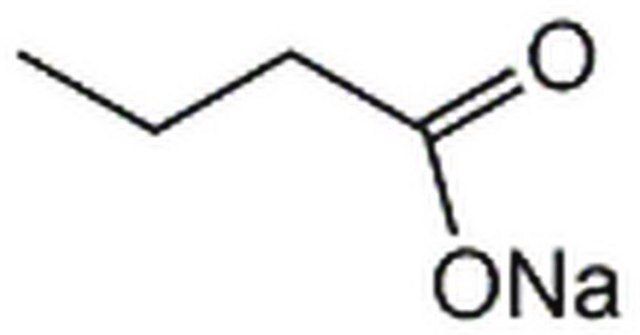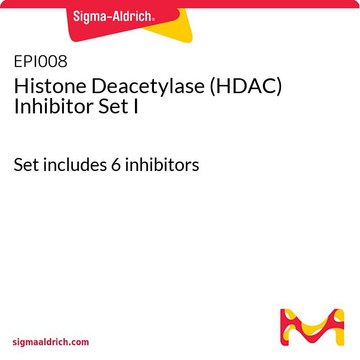EPI005
Histone Deacetylase 3 (HDAC3) Inhibitor Screening Kit
100 assays in 96 well plates
Se connecterpour consulter vos tarifs contractuels et ceux de votre entreprise/organisme
About This Item
Produits recommandés
Utilisation
100 assays in 96 well plates
Numéro d'accès NCBI
Conditions d'expédition
dry ice
Température de stockage
−20°C
Informations sur le gène
human ... HDAC3(8841)
mouse ... HDAC3(15183)
Description générale
Histone deacetylases (HDACs) are a large family of enzymes that remove acetyl groups from histone proteins. Site specific histone acetylation and deacetylation have been shown to activate or repress eukaryotic gene transcription, respectively, and as a consequence, HDACs play a crucial role in mammalian development and disease. HDACs are involved in important biological activities, such as cell differentiation, proliferation, apoptosis, and senescence. Of the several classes of HDACs, this kit assays a member of the zinc-independent, NADH requiring class, HDAC3. With Sigma′s HDAC3 Inhibitor Screening Kit, HDAC3 Enzyme acts with the supplied Developer to deacetylate and then cleave the HDAC3 Substrate [Arg-His-Lys-Lys(Ac)-AFC]. This activity releases the quenched fluorescent group, AFC, which can be detected at Em/Ex=380/500 nm. In the presence of a HDAC3 inhibitor, AFC is not released and its fluorescence remains quenched. The kit provides a rapid, simple, sensitive, and reliable test, suitable for either individual tests or high throughput screening of HDAC3 inhibitors. Trichostatin A (TSA) is included as a control inhibitor to compare with the efficacy of test inhibitors.
Caractéristiques et avantages
- Simple, sensitive, and reliable assay
- Simple procedure; takes ~60 min
- Utilizes fluorometric methods
- Sample type: candidate HDAC3 inhibitors
- Suitable for screening HDAC3 inhibitors
- Suitable for individual tests or high throughput assays and kinetic studies
- Convenient 96-well microplate format
Autres remarques
The kit is shipped on dry ice. Store HDAC-3 enzyme at -80 °C upon receipt. All other components should be stored at -20 °C, protected from light. All -20 °C reagents should be used within 2 months after thawing.
Produit(s) apparenté(s)
Réf. du produit
Description
Tarif
Code de la classe de stockage
10 - Combustible liquids
Classe de danger pour l'eau (WGK)
WGK 3
Point d'éclair (°F)
188.6 °F - closed cup
Point d'éclair (°C)
87 °C - closed cup
Certificats d'analyse (COA)
Recherchez un Certificats d'analyse (COA) en saisissant le numéro de lot du produit. Les numéros de lot figurent sur l'étiquette du produit après les mots "Lot" ou "Batch".
Déjà en possession de ce produit ?
Retrouvez la documentation relative aux produits que vous avez récemment achetés dans la Bibliothèque de documents.
Ji Heon Noh et al.
Cancer research, 74(6), 1728-1738 (2014-01-23)
Aberrant regulation of histone deacetylase 2 (HDAC2) contributes to malignant progression in various cancers, but the underlying mechanism leading to the activation of oncogenic HDAC2 remains unknown. In this study, we show that HDAC2 expression is upregulated in a large
Astrid M Kral et al.
Biochemistry, 53(4), 725-734 (2014-01-24)
Histone deacetylases (HDACs) play diverse roles in many diseases including cancer, sarcopenia, and Alzheimer's. Different isoforms of HDACs appear to play disparate roles in the cell and are associated with specific diseases; as such, a substantial effort has been made
Johannes Gräff et al.
Cell, 156(1-2), 261-276 (2014-01-21)
Traumatic events generate some of the most enduring forms of memories. Despite the elevated lifetime prevalence of anxiety disorders, effective strategies to attenuate long-term traumatic memories are scarce. The most efficacious treatments to diminish recent (i.e., day-old) traumata capitalize on memory updating
Ouafa Zerzaihi et al.
Biochemistry and cell biology = Biochimie et biologie cellulaire, 92(1), 61-67 (2014-01-30)
Besides its direct metabolic effects, insulin induces transcriptional alterations in its target tissues. However, whether such changes are accompanied by epigenetic changes on the chromatin template encompassing insulin responsive genes is unclear. Here, mRNA levels of insulin-responsive genes hexokinase 2
Nicole L Regna et al.
Clinical immunology (Orlando, Fla.), 151(1), 29-42 (2014-02-08)
We sought to determine if a specific class I and II HDAC inhibitor (ITF2357) was able to decrease disease in lupus-prone NZB/W mice through regulation of T cell profiles. From 22 to 38 weeks-of-age, NZB/W and non-lupus NZW mice were
Notre équipe de scientifiques dispose d'une expérience dans tous les secteurs de la recherche, notamment en sciences de la vie, science des matériaux, synthèse chimique, chromatographie, analyse et dans de nombreux autres domaines..
Contacter notre Service technique







